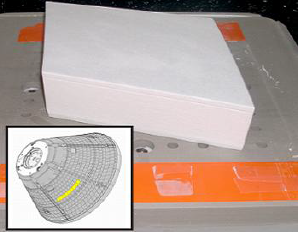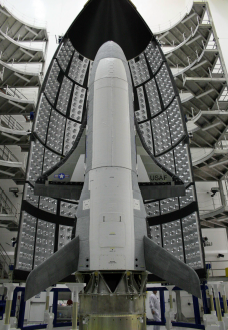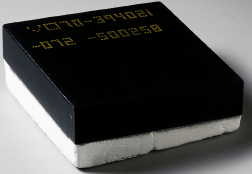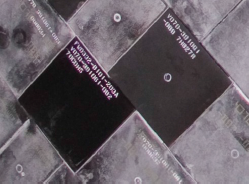Reusable thermal protection systems (TPS) consist of materials that are mechanically or chemically unchanged by flight missions and can be safely flown a number of times (with or without servicing). The Thermal Protection Materials Branch at Ames has developed numerous reusable TPS products such as Silica-based Reusable Tiles AIM, FRCI, and AETB. The Branch was also the recipient of the 2011 Invention of the Year Award for Toughened Uni-Piece Fibrous Reinforced Oxidation-Resistant Composite (TUFROC).
Alumina Enhanced Thermal Barrier (AETB)
AETB is a reusable, higher temperature aluminoborosilicate tile. AETB-8 has a density of 0.13-0.15 g/cc while AETB-12 is 0.17-0.21 g/cc. AETB consists of Nextel® fibers, alumina fibers, silica fibers, and silicon carbide and is very tunable to complex geometries. Typical applications include acreage areas for moderate heat fluxes. AETB is a leading edge candidate for sub-orbital missions with low to moderate heat flux.
Heritage:
- Substrate for TUFI tiles on Space Shuttle and Orion Multipurpose Crew Vehicle backshell.
Toughened Uni-piece Fibrous Reinforced Oxidation-resistant Composite (TUFROC)
The Toughened Uni-Piece Fibrous Reinforced Oxidation-Resistant Composite (TUFROC) represents an exciting leap in reusable thermal protection systems (TPS) technology that allows for much more affordable and sustainable operations involving Space Launch Services and other systems that utilize Earth re-entry vehicles. TUFROC has an exposed surface design and appropriate materials combination for a space vehicle that will survive the mechanical stresses induced in the initial ascent and will subsequently survive the extreme heating and mechanically stressful environment of re-entry. It provides a thermal protection tile attachment system, suitable for application to a space vehicle leading edge and for other uses in extreme heating environments (up to 2900°F, and possibly higher, for short time intervals).
Benefits:
- Flight tested
- Reusable up to 2900°F surface temperature; single use for higher temperatures
- Light weight
- Modular, therefore easily replaceable
- Low cost to fabricate and maintain
- Easier to design – can be fabricated and tested in various configurations
- Reusable thermal protection system
- Provides a composite insulating structure
Heritage:
- Multiple successful X-37b missions completed with continued flights in progress and planned
- A modified TPS derived from TUFROC is baselined for several regions of Sierra Nevada Corp’s Dream Chaser
TUFROC was awarded NASA Invention of the Year in 2011. This invention is available for licensing from NASA’s space program to benefit U.S. industry.
Ames Insulation Material (AIM)
AIM is a reusable, low density silica tile (e.g. AIM-10 is 0.16 g/cc) and is an excellent insulator consisting of 98.5% microquartz fibers and 1.5% silicon carbide. Typical applications include acreage areas expecting low to moderate heat fluxes requiring low thermal conductivity.
Heritage:
- Functionally equivalent to high temperature reusable surface insulation (HRSI) Lockheed LI-900 tiles, which were used on underside of the Space Shuttle Orbiter where re-entry temperatures were < 2300° F.
Fibrous Refractory Composite Insulation (FRCI)
FRCI is a reusable, higher strength aluminoborosilicate tile with improved durability and resistance to coating cracking and weight reduction. Low density – FRCI-12 has a density of 0.17-0.21 g/cc. FRCI is a good insulator consisting of Nextel® fibers, and silica fibers. Typical applications include acreage areas expecting low to moderate heat fluxes where high strength is required. FRCI is a leading edge candidate for lower heat flux sub-orbital missions.
Heritage:
- Space Shuttle – FRCI replaced HRSI tiles where damage had been an issue.
Advanced Flexible Reusable Surface Insulation (AFRSI)
AFRSI is a ceramic insulation blanket used for thermal protection in moderate aerothermal environments. AFRSI is a quilted blanket TPS consisting of a woven silica outer fabric, a woven glass inner fabric, and fibrous silica batting sewn together with silica thread. AFRSI is another example of technology developed by NASA Ames being transitioned to industry (in 1974 for this case) for larger scale production and wider application across aerospace industry. AFRSI was used on a large percentage of the leeside surfaces of the Space Shuttle Orbiter.
A blanket water-proofing agent is typically applied to AFRSI at the factory and again between flights. As flown on the Shuttle Orbiters, AFRSI included a C-9 coating on the outer surface. This coating improved the optical properties of the blanket surface, and helped make the blanket’s top surface fibers more tolerant of aerodynamically-induced abrasion. Although the blanket is very flexible during installation, its surface becomes hardened after application of the C-9 coating and rather stiff after thermal exposure above 1800°F.
Compared to tile-type TPS, AFRSI’s installed cost is relatively low, but its aerodynamic capabilities are more limited. It has a rougher surface than most tiles and therefore has an increased propensity to transition a laminar boundary layer into turbulence. This increased roughness can also produce markedly amplified local heating where boundary layers are relatively thin, such as the windward surfaces of hypersonic reentry vehicles. Additionally, AFRSI has less tensile and shear strength compared to tiles, making it less applicable in areas of high aerodynamic loading; particularly rapidly fluctuating aerodynamic loads and gradients.
Tile Gap Fillers
When rigid ceramic tiles are bonded to a surface, there are typically small gaps left between them to allow for minor structural deflections. In order to prevent hot air intrusion and tile-to-tile contact, gap filler materials are used in areas of large pressure gradients and vibro-acoustic environments. Early in the Space Shuttle Program, Ames developed a gap filler consisting of a ceramic cloth impregnated with a silicone polymer that was adopted as a solution to the gap heating on the Columbia Orbiter. The use of a ceramic (colloidal silica) coating (designated C-9) significantly enhanced the performance of the gap filler. These Ceramic Ames Gap Fillers have successfully survived arc testing to 2500°F, were used extensively for the Shuttle Orbiter fleet and are currently used on the Orion backshell.





























